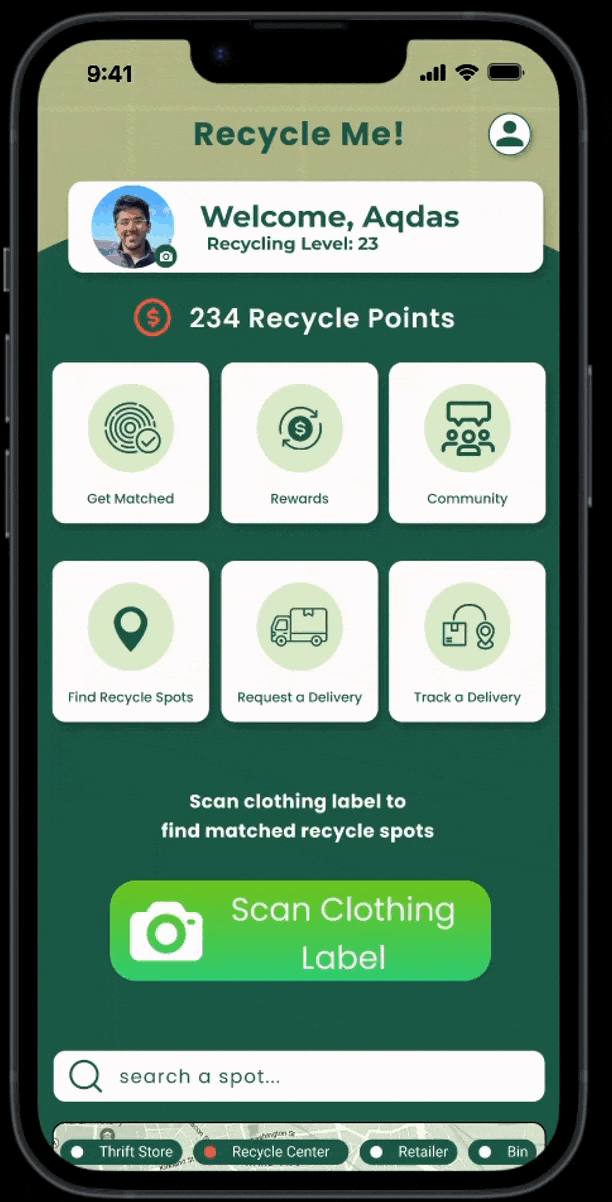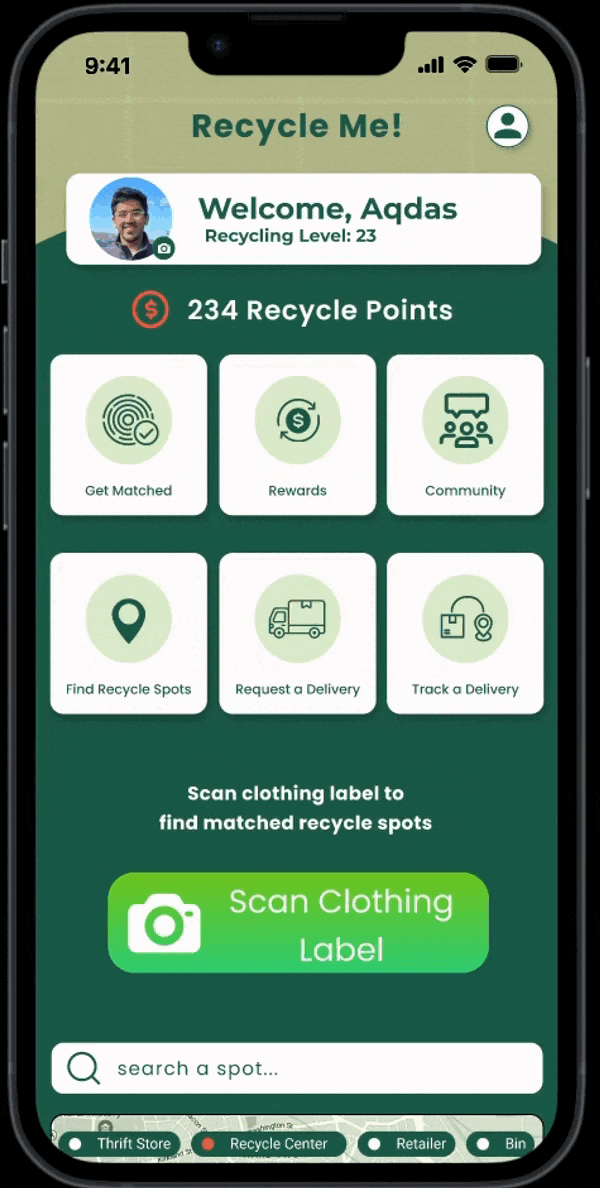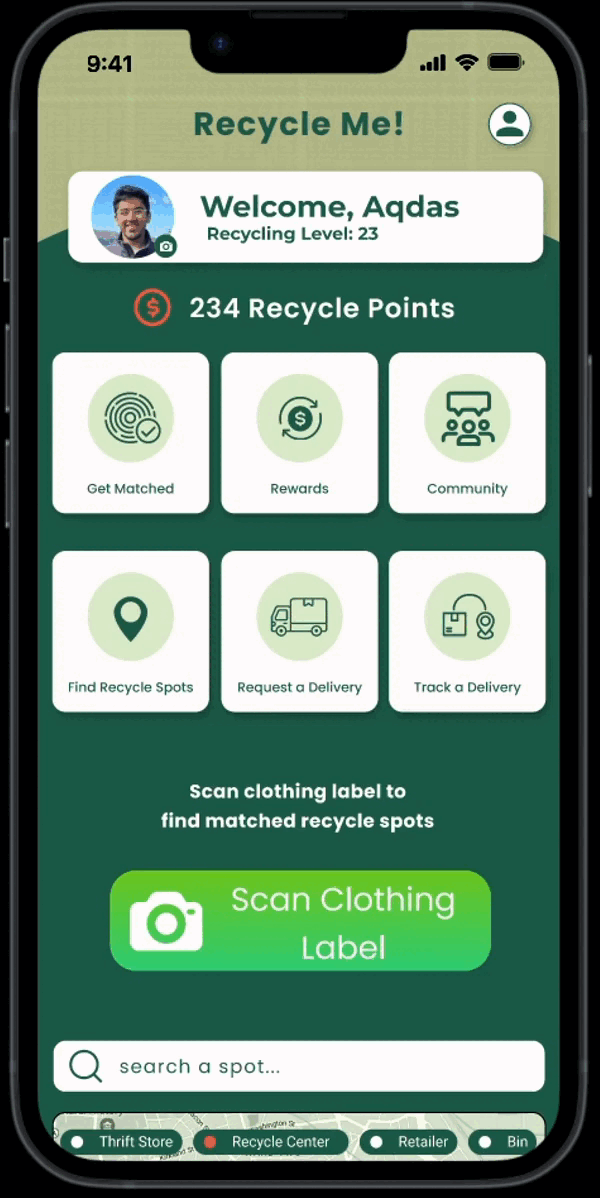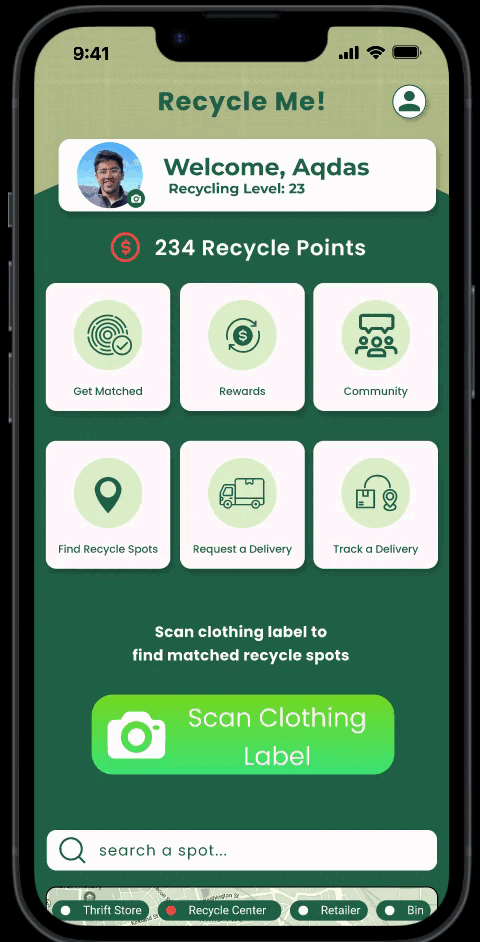
Recycle Me!
An Online Platform for Fast Fashion Industry Waste
Time: 2022 Fall
Team: Mahbuba Sumiya, Mateo Velarde
Role: UX Researcher/Designer, UI Designer
Tool: Figma, UX Research Methods
Current Fashion Industry Waste Situation
The fashion industry is one of the most leading industries to cause substantial waste in the world. Approximately 92 million tons of textile waste come from the fashion industry. The root cause of this problem is overproduction. Every season, about 30% of the clothes that are produced are never sold. This waste projection will increase by around 60 percent from now to 2030. To exemplify the problem more concretely, in March 2018, the fast fashion powerhouse H&M reported 4.3 billion in unsold inventory. Furthermore, textile overproduction by fashion companies produces harmful waste for our planet, where 85% of textiles are thrown away into landfills or burned. Hence, clothing waste is threatening the environment and communities around the world.
Approximately 92 million tons of
textile waste come from the fashion industry
.png)
.png)
85% of textiles
are thrown away into landfills or burned
In 2018 the fashion industry produced 2.1 billion tons,
roughly 4% of global carbon emissions
.png)
Use technology intervention to reduce the fashion industry’s harmful impact on the environment. Our intervention values a circular system that values recycling and reclaiming of products in brands and retailers and customers.

Fashion Value Cycle
Brands and retailers have influence across the value cycle. Decisions conceived at the designers’ drawing table, policies established at HQ, partner choices, and end-of-use strategies are among the many factors that will dictate levels of emissions.
Factories, material producers and other upstream players must be fully involved in and committed to decarbonisation programmes. Brands and retailers should support value chain players in tracking, analysing and benchmarking their carbon emissions and enhancing transparency.
As citizens, we all need to work to extend the longevity of the clothes we wear. We can do that by washing less often and at cooler temperatures and ensuring that we recycle or enable reuse, rather than throwing things away.
Source: Fashion on Climate (2020)
by Global Fashion Agenda and McKinsey & Company
Research Process
Needfinding interviewees:
For this project, we interviewed local thrift stores, branches of larger fashion stores, and consumers to learn more about their involvement in the mass waste of this industry. To contact these individuals, we surveyed shoppers and conducted in-person interviews in clothing stores in Boston Back Bay Shopping Area.
INTERVIEWEES
Local Thrift Shops:
Castanet Designer Consignment
Goodwill
Brands and Retailers:
UNIQLO (JAPAN)
CHAMPION (USA)
H&M (SWEDEN)
Customers:
7 customers shopping at both thrift shops and retailers

USER INTERVIEW DOCUMENTATION
.png)
USER AFFINITY MAPPING

ONLINE SURVEY
In order to know more about specific problems customers are facing, we also conducted an online survey, targeting consumers of different races, ages and cultures to answer questions regarding recycling clothes.

.png)
Concept Process
5*N Ideation & Discussion
After individual brainstorming, the team had a meeting to share our ideas to come up with four distinct concepts. In this process, we found that there were some connections and similarities in some of our ideas generated. As a result, by finding and combining similar ideas in Miro, we came up with four distinct concepts based on the individual ones.
Product 1:
A map-based online application with delivery service
Product 2:
An online social community app
Product 3:
An interactive information application
Product 4:
An application that matched users with places to recycle their clothing
.png)
Product Concepts Hypotheses
Product 1
Product 2
Product 3
Product 4
Assumptions
01
Many retailers, brands and other recycle spots would love to provide the delivery service; while customers would love to pay for delivery service fees
02
Customers would like to download this app for recycling clothes
Needs
Suggestions
Assumptions
01
Customers will find it hard to trust someone else on the platform and worry about being cheated
02
Users find it troublesome to upload images for each of the clothes and would rather throw them all to the recycle centers
03
Users are reluctant to download an app for recycling clothes and they might choose to do that on some existing social apps
Needs
Suggestions
Assumptions
01
Users will have time to see the video and have no idea how the process is
02
Users do not know about clothes recycling programs around them
03
Users are interested in worldwide steps for sustainability and less waste in the environment
Needs
Suggestions
Assumptions
01
Our platform is intuitive.
02
All the consumers will be happy with recommendation and will consider our recommendation highly over their instincts of what they want.
Needs
Suggestions
Hypotheses
01
Customers will find recycling clothes much more convenient
02
Retailers and brands can help to promote fashion sustainability by letting more customers learn about their recycle programs and find it convenient to participate in
Needs
Suggestions
Hypotheses
01
Customers will find clothes they want when they surf the platform instead of spending much time at local thrift shops
02
Customers feel motivated about recycling clothes because they can meet new friends in this process
03
Users find it interesting to share ideas about fashion sustainability and would love to organize some small in-person events in terms of Sunday second-hand markets and workshops about turning an unwanted cloth to a bag/pillow
Needs
Suggestions
Hypotheses
01
Users will be engaged with the interactive videos concerning the recycling process
02
Users who want to learn about nearby recycling options will use the third tab’s information
03
Users who want to learn more about recycling options will enjoy the info/update section on the first tab
Needs
Suggestions
Hypotheses
01
All types of consumers will be able to adapt to the usage of our platform.
02
The platform will be able to meet every user's wants and gives helpful recommendations based on the information given by the users.
Needs
Suggestions
Product Prototyping
For our prototypes, we created Figma outlines for two product concepts. These both show the general appearance and usability of the product.
Product 1: A map-based online application with delivery service
This product is an online interactive map, which helps customers to find recycling spots including thrift stores, retailers, donation centers and recycle bins, aiming to make the recycling information available and transparent. To be specific, users can filter different locations based on distance (considering convenience), incentives (mainly provided by fast fashion retailers and brands), most popular spots (where customers tend to give more trust), etc.
Besides, users can also require delivery options if they collect clothes weighing more than a certain number of kilograms. This feature aims to solve the problem mentioned by more than one-third of the consumers that we have interviewed, that is, it is troublesome for them to bring the clothes to certain spots. As a result, delivery options including those provided by retailers and brands, recycle centers, or self-required ones, have different requirements in terms of the minimum weight of clothes, distances, available pick-up time, costs, etc. Users can decide which one they want to use based on their own considerations. Instead of letting customers find out where to drop off clothes and the recycle spots transport the clothes to warehouses, this feature also aims to streamline this process by reducing the middle collecting spots and directly bringing the clothes from consumers to warehouses.
After finishing recycling, the users can also check where their clothes go, and what they turn out to be.


Product 4: An application that matched users with places to recycle their clothing
Based on user interviews, we realized that consumers care about being sustainable, but there needs to be more convenient access, whether it does not know how to recycle, what can be recycled, or where to go. We want to build a platform that customizes the consumer's experience, from buying clothes to recycling them at appropriate locations. The platform prompts the consumers to input their preferences (options include: sustainability bar, types of clothes looking to buy, brands, second-hand, get connected to recycling program) and it gives them recommendations after the questions are answered. Brands or stores are able to reward the consumer if the consumer chooses to recycle an item. Incentives can range from coupons, reward points, or getting verified on the platform by brands/stores. At the store, consumers are able to scan any item using our platform to get details of the item's sustainability. This solution addresses the problem statement by informing the consumers what they are buying, which might influence their decision of wanting to buy something or look for alternatives.


User Test
For testing our hypotheses, we conducted seven user types of research by showing our interviewees the two products that we built for milestone 4. Since we were quite clear that our final product would be the one that combines features from both prototypes, we conducted the user test mainly to find out the most attractive features for users instead of comparing these two prototypes.
When we reached out to users, we mainly focused on reaching out to people living in the US and in different ages, races, and occupations. And finally, we concluded our user research results on the Miro board. We divided the seven features into three categories: like, maybe, and dislike when we interviewed the users. Besides, we also recorded their backgrounds and other ideas they had.
.png)
Recycle Me!
Final Product
Our user test results demonstrate that consumers need to recycle their excess clothes. Still, the recycling process is uncertain regarding where the items are recycled and how different brands support sustainability efforts as their brand persona. During our interviews, we also identified that some consumers avoid recycling their excess clothes due to the lack of transportation assistance and the time needed to find the right recycling places for the items they want to give away. Another group of interviewees also did not trust the recycling places because they thought their items would go in the landfills regardless. Consumers aren’t aware of what recycling options would be best suited for their excess clothes and how they can benefit from recycling branded items. Some brands don’t advertise their recycling programs and the benefits that exist for consumers who recycle their items. Consumers are more likely to recycle if they are incentivized in some way.
Recycle Me provides a personalized recycling service to the consumers on the platform. Consumers can answer a short survey that collects information about the type of textile they want to recycle and its condition (options are new, lightly, and heavily used). They also can scan a tag (in-store or already bought) to match that specific brand's recycling options. After they pick a recycling program from their matches, finding a recycle spot on our platform allows the consumer to input a pickup and the location of their match to receive transportation assistance. All the matches provide the best recycling option based on the consumer's current location and the item they want to recycle. Once the driver picks the items, they get assigned an order number. The order number is to help track the items. Consumers can see if their items were delivered at the right location and where the organization/brand shipped the recycled items.
Our platform also provides a world map that puts a marker on the map where items were shipped to allow the consumers to see their recycling stories and share them with their friends and family to encourage them to join sustainable efforts like theirs. Additionally, brands/organizations will provide incentives to the consumers who go through the process of recycling clothes. The incentive varies depending on the matches. Some brands will provide rewards points that can be used to redeem points at their stores for discounts, or they can redeem their points at local restaurants that support sustainable efforts in fashion.
As a result, five main features of this platform are: get matched, delivery service, recycle story, connect to community, and redeem rewards.
1
Get Matched

2
Delivery Service

3
Recycle Story

4
Connect
to
Community

5
Redeem Rewards

